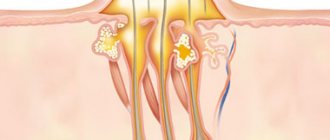It all depends on the type of intervention
In fact, it is quite difficult to give an unambiguous answer about the possibility and advisability of visiting a bathhouse after undergoing surgery, if only for the reason that these same interventions can be of a very different nature.
It’s one thing when surgery is performed, for example, on a finger for paronychia. In this case, after a few days you will have no restrictions on visiting the steam room. However, if you feel fine and the wound is isolated, then you can go to the bathhouse the next day after the operation.
https://www.youtube.com/watch?v=p2xAHDl9asM
It's a completely different matter when it comes to performing abdominal operations. Deep intervention, general anesthesia, severe anesthesia, complications after surgery - all this can lead to restrictions on visiting the bathhouse and many other types of recreation for a very, very long time.
Cool head in a hot steam room
We continue to tell you about how to properly go to the bathhouse and take a steam bath. It is very important to keep your head dry. That is, when taking a shower, you should absolutely not get your hair wet. If you neglect this rule, you can easily get it. In general, all avid bathhouse attendants know that you need to put a hat made of natural wool or cotton on your head. By the way, it wouldn’t hurt to soak it in ice water and squeeze it out properly. This will provide even better head protection and prevent accidents. Now you are ready to meet the hot climate of the Russian steam room. Don't expect to sit here for long right away. This is not only unnecessary, but even harmful. During the entire time you are in the bathhouse, it is better to make 5 to 10 visits to the steam room, and spend the rest of the time in the pool or in the relaxation room.
The effect of the bath on the body
Every person knows that a bathhouse is not just an opportunity to wash off dirt. This is a rather pleasant pastime in a warm wooden room filled with natural aromas. It is also a real storehouse of health, because exposure to high temperature and humidity has a beneficial effect on the functioning of almost all body systems.
Important! The bathhouse is useful only when the temperature regime is maintained and the person feels comfortable inside. If bath procedures cause discomfort (shortness of breath, weakness, dizziness), it is better to temporarily stop them and consult a doctor.
What happens to the body when a person enters the bathhouse? First, the body warms up slowly through the skin and lungs. As it warms up, the temperature of the blood and tissues increases, so the blood supply accelerates by about 3-4 times. The process of thermoregulation is gradually activated, substances that dilate skin vessels and stimulate sweating are released into the blood. Thanks to the sweat released, the body partially cools down.
At some time, the blood temperature reaches 38 degrees, and the internal organs begin to warm up. Sweating increases, and if fluid loss is not replenished, the salt balance will be disrupted and heat transfer will deteriorate. Stronger heating leads to fatigue and muscle weakness. There is a risk of heat stroke. The heart beats at a frequency of up to 185 beats per minute, which is dangerous for health and even life.
All people tolerate baths differently. For some, 10 minutes is enough to start feeling a racing heart and experiencing shortness of breath. And others can easily tolerate high temperatures and prolonged vaping.
Primary ablution
Speaking about how to properly go to the bathhouse, it is necessary first of all to emphasize the importance of preparing the body. That is, you don’t need to go straight to the steam room - first rinse yourself in a hot shower. In this case, the water should be warm enough. The optimal temperature is 38 degrees, this is enough to prepare the body for the upcoming test of high temperatures.
At this stage, the task is to warm up the skin, so leave the soap and washcloth for later. The fact is that soap actively destroys the lipid layer, which is designed to protect our skin. By washing away this barrier, we leave the skin defenseless against the high temperature of the steam room, which will dry it out to parchment.
The dangers of visiting the steam room after surgery
One of the main limitations in visiting a bathhouse after an intervention is weakness and a general decrease in the body’s resistance after severe stress, which can be considered an operation.
After stabilization of the condition, the danger may lie in the penetration of infection into the wound, and it is one thing when the wound is small and can be isolated well enough, but quite another when it is huge, and the likelihood of pathogenic bacteria penetrating into the soft tissue is very high.
It is also worth understanding that a lot depends on the reasons for which the surgical intervention had to be performed. If you have had a broken leg, after which you have fully recovered, then you can visit the bathhouse without any restrictions. But if the operation involved stenting the coronary arteries or other intervention aimed at eliminating the pathology of the cardiovascular system, then, of course, it is better for you to refuse the bath.
Conclusion
If you have any contraindications, you should spend as little time as possible in the bathhouse, and it is best to completely avoid the steam room. Of course, it is quite difficult to leave yourself without pleasure, but it would be much more rational to first cure the disease, and only then subject the body to stress. The video in this article contains additional information as well as some useful tips on this topic.
The bath is a recognized remedy for many diseases. While taking thermal procedures, you can not only have a pleasant time, but also improve the health of your entire body. The benefits of a bath for a healthy person are obvious. But there are times when people wonder whether it is possible to steam if they have a particular disease. For example, is a bath indicated after a fracture?
Is it dangerous to steam after surgery?
From a medical point of view, surgery involves surgically disrupting the integrity of tissues. This means that any intervention ends with stitches. And this is the first reason why you should not go to the bathhouse after surgery. The bandage will become wet and healing will be significantly impaired. And if the seams are fresh, they will easily come apart due to the expansion of pores and stretching of the skin.
Even if the bandage has already been removed and the stitches are healing, it is too early to go to the bathhouse. Despite the fact that steaming is a hygienic measure, there are plenty of bacteria in the humid air, and infection can easily get into the wound. And this is suppuration, sepsis and long-term treatment.
The second reason why it is dangerous to visit a bathhouse after a recent operation is that the body is unprepared. Surgery is stressful. Plus anesthesia (especially if it was general) and rehabilitation with the help of medications. All this seriously undermines health, and the body needs time to recover. Even if the patient feels great, it is better to wait for the prescribed period, and then go to the steam room with peace of mind.
We invite you to familiarize yourself with the Concrete floor in the bathhouse - All about the bathhouse
Broom massage
First of all, plowing of the person lying on the shelf is performed. In this way, the injection of hot air is achieved. The massage continues with shaking. This is shaking a broom under the ceiling of the steam room and briefly pressing it on the feet, lower back and shoulder blades. Now you can move on to whipping and light blows to the skin. It is imperative to alternate them with lingering strokes. An excellent type of massage is a compress. A hot broom is lowered onto the skin with firm pressure for 4-5 seconds. Do not forget that although this procedure is pleasant, you should not drag it out too much. 5-7 minutes is enough, after which you need to lie down for another 2-5 minutes, relaxing as much as possible, and only then you can get up and go to rest.
The main thing is to approach it wisely
You need to independently think about the presence or absence of restrictions for visiting the bathhouse after undergoing surgery, or consult with a specialist, but the main thing is to approach the issue wisely.
You should not think that surgery is in itself a limitation for visiting the steam room, or that you can go to the steam room, regardless of what kind of surgery you had to undergo.
Think about your health, the balance between potential benefits and risks, and only then make your final decision. It is this approach, on the one hand, that will allow you not to limit yourself in your favorite vacation, but on the other hand, not to risk your health in vain.
Getting used to the heat
Today we are talking about a classic steam room, where water pours onto the heater and the dizzying smell of leaves from a broom. And in order to easily endure the heat, you need to know how to properly go to a Russian bathhouse. In order for you to have the most pleasant impressions, you need to make the first adaptation run. The optimal temperature in this case is +60 o C, that is, the bottom shelf of the steam room is suitable. Lie on it and get used to the conditions. The first run usually lasts 3-10 minutes, so don’t be too zealous. For now, you just need to steam the broom, the most important thing is yet to come.
When and how can you start steaming?
How much time should pass between the operation and a visit to the steam room? The length of the interval depends on the type of surgery.
- After plastic surgery, which does not involve affecting vital organs, you can take a steam bath after a month and a half, i.e. when the stitches are completely healed. If it was plastic surgery with the insertion of implants (breast, buttock), then you will have to forget about the bath for a longer period: 4-6 months.
- Also, you need to wait 1-1.5 months after simple ordinary interventions such as removing the appendix, repairing a hernia, cutting out wen, etc.
- If an intervention was performed related to the surgical treatment of hemorrhoids (removal of polyps, lumps), you will have to wait 2-2.5 months. The bath accelerates blood circulation, and hemorrhoids are a disease associated with the functioning of blood vessels.
- After surgery on internal organs (stomach, liver, kidneys, genitourinary system), you will have to refrain from vaping for six months, because the external and internal sutures need to heal.
- After some heart operations (bypass surgery, installation of a pacemaker, ablation), sometimes there is a complete ban on visiting the bathhouse.
It turns out that the minimum period that must be waited after surgery before visiting the bathhouse is 1 month. During this time, simple seams have time to heal.
Attention! The exact timing of admission to the steam room is determined by the doctor. The above figures are based on the fact that the operation took place without complications or deterioration in health.
Is it possible to play sports?
Between the left atrium and the ventricle is the mitral valve, the function of which is to allow blood to pass from the atrium. Overlapping with two valves (anterior and posterior), it prevents the return of blood flow, thereby ensuring its constant circulation through the vessels.
Prolapse is a valve malfunction that causes blood to return to the atrium.
This effect is caused by deflection of one or both valves, the degree of which determines the severity of the disease. When the body experiences increased physical activity, this provokes an increase in the amount of blood pumped into the atrium. So is it possible to play sports with stage 1 mitral valve prolapse?
The first degree is the mildest form of this disease. Most often, this pathology is congenital and is detected in children, mainly girls.
Admission to sports with grade 1 prolapse is determined as a result of an individual examination. Light exercise is recommended for all patients, as it helps keep the body in good shape. The possibility of more serious sports activities is allowed in the following situations:
- If the patient does not experience heart rhythm disturbances leading to loss of consciousness.
- In the absence of unstable rhythms or sudden disruptions in the functioning of the heart. These symptoms are determined based on electrocardiogram data.
- There is no valve insufficiency, which is determined by ultrasound with Doppler ultrasound.
- The patient had not previously suffered thromboembolism.
- There were no deaths in the family due to this disease.
Physical activity for mitral valve prolapse of moderate and high intensity is unacceptable if the patient has at least one of the above symptoms.
Possible consequences for the body
What can happen to a person who disobeys the doctor and goes to the steam room ahead of schedule? Firstly, the seams may come apart. It is painful, unpleasant and dangerous, because it can cause bleeding and infection. And if the bathhouse is located outside the city, the problem of emergency transportation of the victim to the hospital arises.
Secondly, your health may worsen. Depending on the immune system, age and type of operation performed, this manifests itself in different ways: from shortness of breath and increased blood pressure to loss of consciousness and cardiac arrest.
Thirdly, specific force majeure events may occur. If it was an umbilical hernia hernioplasty with the installation of a mesh, the latter may lose its properties under the influence of high temperatures. And the hernia will easily burst again. If the patient has had implants inserted, they may move in the bath, ruining the aesthetic result. In a word, it is better not to take risks.
Bathhouse - an assistant in the fight for a beautiful figure
All women have probably asked this question, so finally we will look at how to properly go to the sauna for weight loss. How can a steam room help you lose weight? It turns out that it is very simple: under the influence of high temperatures, a process of severe sweating occurs. The fluid leaves, and the body makes up for its deficiency by melting it from fat deposits and muscles. This starts the process of breaking down and removing fat through the pores. Of course, you won’t lose much, and besides, strong thirst will force you to drink a fairly large amount of water, which will compensate for the loss. But the running process is very beneficial for the whole organism. Today, the program has proven itself to be excellent, which includes a visit to the Russian steam room, then a cleansing peeling of the whole body and a manual anti-cellulite massage. This procedure ends with mud or
To summarize, I would like to add that the Russian people have honored the bath traditions for centuries, which means that it is very useful for us to continue the traditions of our great-grandfathers and go to the steam room. At least a couple of times a month. The bathhouse strengthens the body and relieves numerous diseases, gives a second youth, lifts the mood, and acts on the skin in almost the same way as expensive salon procedures. Therefore, if you are still in doubt, heed the advice: go to the bathhouse!
Rules for visiting the bathhouse after surgery
To prevent a bath from becoming a pleasant event into a troublesome and dangerous one, a person who has recently undergone surgery needs to follow several rules. This is especially true for the first 3-5 visits.
- You shouldn't steam alone. You need to take someone with you who can provide immediate assistance if necessary.
- At the first urge to feel worse, immediately leave and do not enter again.
- The first visit to the bathhouse should not be long. You need to get used to the steam room gradually.
- Do not rub the area around the wound with a washcloth or pour hot water on it.
- Be sure to follow the drinking regime.
After surgery, many people are guided not by doctor’s instructions, but by advice from forums. One person will write that he went to the bathhouse 3 weeks after the intervention, and nothing happened, and someone will consider this as an indicator. But this is a risk in any case. And if nothing happens to one patient, problems may begin for another. And the complexity of the operation, the type of wound, the state of health - all this also matters.
Preparing for the bath ritual
It can be called that way. For the Slavs, the bathhouse was an almost holy place. Sick people were brought here to heal them, a newborn child was washed in the bathhouse so that he would grow strong and healthy, the bathhouse was also flooded at the moment of a person’s death to wash him. Today we go to the steam room purely for pleasure, because every home has a shower and hot water, but the smell of warm wood and an oak broom cannot be replaced by anything else.
So, how to go to the bathhouse correctly? First of all, you should not eat enough before visiting the steam room. The last, light snack should take place no later than 1.5 hours before the event. Take kvass, mineral water, compote or natural juice (for example, birch) with you. But you need to forget about alcohol on this day.
A hot shower is enough to keep your body clean. The bathhouse is completely different, it is a place of power. The Russian bathhouse is highly hygienic and has medicinal value. However, you should not visit the steam room too often. It’s not for nothing that there is a generally accepted standard to go steam on Saturdays. Once a week is the optimal frequency. Moreover, the meaning of such an event is much deeper than simple washing of the body. Such regularity will help strengthen the body and avoid many diseases in the future.
Rehabilitation after removal of prostate adenoma
Prostate adenoma after surgery reduces the severity of symptoms for about 13-15 years; according to statistics, only one in ten patients who have undergone surgical treatment return again.
In the postoperative period after removal of prostate adenoma, a system is most often installed to irrigate the bladder cavity with disinfectant solutions.
After surgery, a catheter is inserted into the bladder to drain urine and blood. After surgery, you will be moved to the recovery room for post-operative observation. If the recovery period is uneventful, you will be discharged home within a day after the operation.
After the necessary surgical procedures, an equally important rehabilitation stage begins. The usual rhythm of life returns gradually under the supervision of a specialist. During the first two weeks after surgery, the entire list of recommendations of the attending physician must be strictly followed, even if the patient feels well. The catheter remains in the urethra for 4-7 days.
We suggest you familiarize yourself with How to treat the inside of a sauna barrel
Before heading home you will be advised to:
- Do not take blood thinners until your doctor says you can resume taking your medications.
- Limit activities that require significant effort, such as heavy lifting, for 1 month after laser treatment for prostate cancer.
So, in case of prostate adenoma, the postoperative period includes the following points:
- avoiding sudden body movements and inadequate physical activity - this can lead to damage to the scar;
- drinking plenty of water;
- balanced nutrition, adherence to a diet - avoidance of salty, spicy, smoked, fried foods;
- carrying out antibacterial therapy;
- constant monitoring by the attending physician;
- maintaining a healthy lifestyle - not drinking alcohol, walking in the fresh air;
- abstinence from sexual activity for 1.5 months;
- You can and should take a shower and wash your genitals, but avoid baths and saunas for 1 month.
The first time after treatment of prostate adenoma with a laser, you may be bothered by the following symptoms:
- Hematuria (blood in the urine) may persist from several days to 1 month after surgery. If bleeding is heavy, be sure to contact your doctor.
- Symptoms of urinary dysfunction (pain, frequent urination, urgency, difficulty, incontinence) may persist for several weeks after surgery.
- Content:
- How do baths and saunas affect the prostate? Is it possible to take a steam bath with prostatitis?
- Is it possible to go to the bathhouse if you have adenoma?
- Bath and prostate cancer
Several years ago, urologists categorically forbade taking a steam bath for prostatitis, prostate adenoma and prostate cancer. Thanks to a better understanding of the processes leading to inflammation and other problems in the prostate, general recommendations have been developed that have changed the approach to heat treatment and warming up the pelvic organs. Some experts themselves will recommend visiting a bathhouse or sauna.
Second call: moving on to bath procedures
After you've had a good rest, it's time to go to the steam room again. Now the period of stay there can be extended to 10-15 minutes. During this time, you can not only sweat, but also try the healing power of a broom. To do this, it is best to go to the bathhouse together. Don’t forget: we take a steam bath correctly. Soaring with a broom (we'll tell you the rules now) is a procedure that not many people know today. At the same time, the expression “whip with a broom” is completely inappropriate here. For the procedure to be useful and enjoyable, you must first study this sacrament.
How baths and saunas affect the prostate
Disturbances in the functioning of the prostate gland are primarily associated with the appearance of congestion in the pelvic area. The positive effect of the bath on the prostate is due to tissue warming and improved blood microcirculation. Increased lymph flow helps to quickly remove toxins from the body and eliminate congestion.
In addition to improving overall well-being, the benefits of a bath include strengthening the cardiovascular system. At the same time, there is a psychosomatic effect: stress and depression are relieved. Visiting a steam room strengthens a man’s immunity and increases the body’s resistance to infections.
Most experts agree that steaming the prostate can and should be done. The exception is cases of acute inflammation and malignant neoplasm.
Inflammation of the prostate gland occurs due to the development of congestion in the pelvic area, an infectious and non-infectious catalyst. If you have prostatitis, you can go to the bathhouse, provided you follow some recommendations and there are no direct contraindications.
General urological recommendations include compliance with the following instructions:
- Visiting the bathhouse for prostatitis is recommended during the period of non-exacerbation of the disease.
- Steaming is not recommended during acute inflammation, when body temperature rises above low-grade levels. During the period of exacerbation of prostatitis, it is better to provide the pelvic organs with absolute rest. You can visit the steam room as soon as the disease becomes latent.
- Sauna for prostatitis is recommended during chronic congestion. In the steam room, the air temperature warms up to over 80°. At the same time, humidity remains within 25-30%. Dry heat has a positive effect on the body as a whole and in particular on the functioning of the prostate gland. In case of acute prostatitis, it is better to avoid any thermal effects on the prostate.
- An infrared sauna is contraindicated for purulent inflammatory processes and malignant tumors.
You can steam with chronic prostatitis, but with minor restrictions. Contrast procedures: jumping into a pool with cold water, dousing is prohibited. Hypothermia can provoke an exacerbation of disorders. If you have chronic inflammation of the prostate, you can go to the bathhouse, but during periods of exacerbation you should refrain from visiting.
In the case of prostate adenoma, we are talking about tissue proliferation - a benign tumor process. Overheating of the pelvic organs affects the acceleration of hyperplasia. A balanced visit to the bathhouse and sauna leads to a decrease in the symptomatic manifestations of the disease: a decrease in the intensity of pain and normalization of urination.
You can take a steam bath with prostate adenoma only at stages 1-2 of the disease. After the adenoma reaches stage 3 of development, the patient is operated on. You can take a steam bath after removal of the prostate only after the man has fully recovered, provided that cancer has been ruled out. Limitations after surgery: bleeding and acute urinary retention.
We suggest you familiarize yourself with How to bring water from a well into a house and a bathhouse: video instructions for do-it-yourself installation, photos
You can go to the bathhouse after surgery to remove prostate adenoma no more than once every two weeks. If your health worsens, you should avoid visiting the steam room. As the body gets used to it, the number of visits is increased to 1-2 times a week.
You can use an infrared sauna for prostate adenoma if the malignant nature of the tumor formation is excluded.
A direct contraindication to visiting the bathhouse is the development of prostate cancer. Thermal exposure contributes to the accelerated growth of malignant tumors. Going to the bathhouse if you have prostate cancer is strictly prohibited.
Pair incompatibility remains in the following cases:
- Carrying out radiation therapy - infrared and any other heating of tissues can minimize the therapeutic effect of radiation. Visiting the bathhouse after radiation therapy of the prostate is dangerous, as it can provoke a rapid relapse of the disease.
- Surgical removal of a tumor - even after complete excision of malignant tissue, thermal exposure of the surgical site is indicated as a contraindication. Going to a bathhouse or sauna, or sunbathing in the sun after removal of prostate cancer is prohibited.
It is known that a bath stimulates the body's metabolic processes; the combination of a hot steam room and dousing with cool water increases the production of red blood cells, hemoglobin, etc. and so on, you can continue in this spirit for quite a long time. All this suggests that wound healing will occur faster.
However, not everything is so simple; the bathhouse stimulates not only the restorative functions of the body. If postoperative inflammation is not relieved, visiting the bathhouse will stimulate inflammation, thereby further intensifying it. Also, in the bathhouse, insufficiently tightened postoperative sutures can come apart, opening the door to infection.
The first thing you need to remember: you can’t go to the bathhouse if the inflammation is not relieved and the surgical wound is not healed enough.
Extreme temperature changes
Since today we are talking about the body, we must definitely talk about the favorite entertainment of the Russian people. This means diving into an ice hole, wiping yourself down with snow, and at worst, you can pour ice water on yourself from the gang. But! We must remember that this is a lot of stress for the body, so if you have just recently started going to the steam room, you should not test your strength. Start by swimming in the pool; the water in it is usually just cool. Gradually lower the temperature of the water used for contrast procedures. Hardening is a process that is designed to be beneficial, so approach it wisely.
Professional sports
Even those women who have attended any sections for many years may have a voiced problem. Further sports activities during uterine prolapse should be slightly adjusted so as not to cause harm to health:
- Lifting the barbell. Perhaps it was precisely because of improper physical activity that the critical situation that was voiced was created. If the trainer never asked his ward about her menstrual cycle while lifting serious weight, then the woman definitely chose the wrong specialist. The doctors’ verdict in this case is clear: if you have pelvic organ prolapse, you should forget about the barbell, even when using a special belt or gynecological pessary.
- Martial arts. Recently, many ladies have begun to actively attend martial arts sections in order to be able to further protect themselves. Some of them can achieve (by the time they discover uterine prolapse) quite significant results in sports. However, sudden movements during pelvic organ prolapse are strictly prohibited, as are all strength exercises of any variety. The only way to keep the body in good shape is physical exercise during uterine prolapse.
- Swimming. “Yes and yes again” is the unequivocal opinion of experts on this matter. It is the continuation of this sport in parallel with Kegel gymnastics that brings tangible results in the fight against uterine prolapse. The muscles that hold the main reproductive organ of a woman will only become stronger during the next visit to the pool, which is important for pelvic organ prolapse.
- Race walking. In this case, you should not refuse training, even if the gynecologist made the described diagnosis. Like swimming, walking will help strengthen the pelvic muscles, which cannot be said about the same obstacle course.
- A ride on the bicycle. This sport is accompanied by a certain shaking of the body, which is definitely not a positive thing for pelvic organ prolapse. This is especially true for those moments when movement on this vehicle occurs on uneven terrain with potholes.
We recommend reading the article about plastic surgery for prolapsed cervix. From it you will learn about the purposes of surgical treatment, the use of mesh, shortening of ligaments and other methods.
Women who are at a loss whether it is possible to engage in fitness during uterine prolapse or other physical exercises should first consult with their doctor. Only a specialist can recommend an individual treatment plan for each representative of the fair sex with such a rather delicate problem.
Source: ProMesyachnye.ru
Gymnastics for prolapse
Every morning you need to start not only with a good mood, but also with some physical exercise. You can play sports during uterine prolapse, but you should consult a doctor and discuss what is acceptable in each case. Most often, a woman with prolapse will be advised to do a similar set of morning exercises:
| Type of exercise | How to do |
| Warm-up while standing | First of all, a woman needs to prepare her body for further manipulations with it. You should put your hands behind your back and then clasp your hands in this position. Subsequently raising your upper limbs upward, you need to stand on your toes, while protruding your pelvis forward to the maximum. |
| Standing exercises | After such warming up of the muscles, physical education can be continued in the form of exercises according to a principle similar to the previous method. In a standing position, you need to turn your hands clasped behind your back in different directions, after which the pelvis and shoulders will echo the given body movements. In this case, the leg that is not in support should be raised on the toe, because it can be continued with the help of active walking with a small ball between the legs. |
| Marching | The last stage in the announced complex in a standing position is marching in place with high legs raised in a fairly active mode. In this case, the hands must be placed at the waist, and the socks must be placed up, which corresponds to the anti-ballet pose. |
| Exercises while sitting | In this starting position, you should place your palms closed into a fist between your thighs. With your hips akimbo in this way, you need to bring your knees together and try to squeeze your hips as much as possible for 15 seconds. Then it is recommended to straighten up and try to touch your toes with your fingertips. |
| Exercises while sitting on a chair | To strengthen your intimate muscles, you need to sit on the edge of a chair, holding on to its edges with your hands for safety, so as not to fall from it. At the same time, you need to hold the ina straight, straining it in parallel with the maximum clamping of the abdominal muscles. During this exercise, it is advisable to keep your chin parallel to the floor. Then you need to take a deep breath and exhale, after which you should lift your buttocks off the chair and raise your pelvis. It is necessary to perform all the described actions in such a way that the butt can form a single straight line with the body and legs. After this, you need to return to the starting position, and then repeat similar manipulations with your body another 15 - 20 times. |
| Exercises while lying down | Sitting on the mat for morning exercises, you need to turn on your right side and bend your leg at the knee. In this case, the second leg will work, which in a straight position should make movements in amplitude up and down. The same manipulations should be repeated when turning to the other side. After this exercise, it is recommended to bend your knees while lying down and then lift your buttocks up (the shoulder blades should not come off the floor). Physical therapy for uterine prolapse does not end with these exercises; it should be supplemented with intimate activities. |
| Kegel exercises (wumbuilding) | This experiment is very popular among the female population who suffer from uterine prolapse. Intimate gymnastics of this kind includes alternately squeezing and unclenching the pelvic floor for 10 seconds. There are many exercises of this nature, but the main thing is to avoid tension in the abdomen and buttocks as much as possible. |
All of these movements must be performed in combination to achieve the best results. Otherwise, there will be no benefit from morning exercises and the loss of precious time, which is unacceptable with an active daily routine for energetic ladies.
We recommend reading the article about prolapse of the uterine wall. From it you will learn about the reasons for changes in the position of the uterine walls, symptoms and consequences, and the necessary physical activity.
Yoga for uterine prolapse
Even if certain physical exercises are prohibited for pelvic organ prolapse, this technique will not harm the woman. If you have a dilemma about what kind of sports you can do when your uterus prolapses, you should try the following yoga complex from famous masters of this art:
- Relaxation in a lying position. With this position of the body, you need to place your heels on the floor and take a deep breath. Then you should turn your head and legs in the opposite direction to each other. It is recommended not to breathe for 5 seconds.
- Exercise lying on your stomach. In the stated position, you should rest your forehead on the floor, while bringing your heels together. The position of the hands during this exercise should look like this: the thumbs are pressed to the palm, and the clenched fists themselves are located in the hip bone area. The further action while exhaling is to raise the legs as much as possible without bending them for the permissible time of holding the breath.
- Exercise in a sitting position. In this position, you need to spread your legs so that your buttocks are in close contact with the floor. Then you need to control your breathing according to the pattern “exhale – squeeze the muscles in the perineum – inhale – relax them.”
- Return to the lying position. You should raise your legs and squeeze your pelvic muscles to perform this exercise. When lowering the lower extremities smoothly, it does not hurt to continue such contractions for as long as possible.
Ideally, you should sign up for local practice centers so that at least in the first stages you can see how teachers act, so that you can then independently repeat their movements. After all, the result of the lessons also depends on how accurately they are reproduced.
Watch the video about uterine prolapse:









